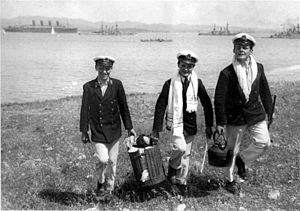Midshipman facts for kids
A midshipman is a young person training to become an officer in a navy. They are usually the lowest officer rank in navies like the Royal Navy (UK), United States Navy (US), and many navies in the Commonwealth. Countries that use this rank include Australia, New Zealand, South Africa, Pakistan, India, Singapore, Sri Lanka, and Kenya. Before 1968, the Royal Canadian Navy also used this rank, but they changed it to naval cadet.
Contents
What is a Midshipman Today?
In the modern Royal Navy, a midshipman is the second lowest officer rank. They are above all enlisted sailors and warrant ranks. A midshipman's rank badge is a white patch with a gold button and a white cord twist on each side of their coat collar. This design has stayed almost the same since the time of the Napoleonic Wars.
To join the Royal Navy as an officer, you need good grades in subjects like English and maths. You also need to pass a tough two-and-a-half-day test called the Admiralty Interview Board. This includes a medical check-up. If you join after university, you start as a sub-lieutenant. If you don't have a university degree, you start as a midshipman.
Basic training for Royal Navy officers happens at the Britannia Royal Naval College. This training can last up to a year. All midshipmen complete at least the first two terms, which are 14 weeks each. During this time, they are called "Officer Cadets" instead of their full rank.
In the first seven weeks, officer cadets learn about military life and how to be a good leader. They also learn important team skills. In the next seven weeks, they learn key sea officer skills. This includes navigation, understanding the marine environment, and basic sea survival. During the second term, officer cadets spend 10 weeks on real warships. They work as junior sailors to gain experience. After this, they return to the college for their final leadership test. If they pass, they officially graduate from the college.
After basic training, midshipmen who specialize in warfare stay at the college for more courses. These courses help them earn part of a university degree in Naval Studies. Officers can also study for degrees through distance learning. Once they finish all their training, midshipmen take a final exam called the Fleet Board. If they pass, they become a fully commissioned officer.
In the United States Navy and United States Marine Corps, students at the U.S. Naval Academy are called midshipmen. They are considered officers, but their power is limited because they are still training. Midshipmen are a special rank that fits between different types of Warrant Officers.
Students at the United States Naval Academy are midshipmen in the U.S. Navy or Marine Corps. Students in the Naval Reserve Officer Training Corps (NROTC) are midshipmen in the Navy or Marine Corps Reserve. Students at the United States Merchant Marine Academy are midshipmen in the Merchant Marine Reserve. The students at the Naval Academy are known as the "Brigade of Midshipmen."
Members of Congress and the Vice President can each nominate five people to attend the Naval Academy. The Secretary of the Navy can also appoint 170 enlisted sailors or marines each year. Children of Medal of Honor recipients can also apply without a nomination if they qualify.
Midshipmen wear uniforms similar to commissioned officers. Their shoulder boards and sleeve badges show their school year or rank. They wear gold anchors on their caps and shoulder boards. Marine option midshipmen wear gold globe and anchor badges.
The Naval Academy started giving out Bachelor of Science degrees in 1933. The first class to receive this degree was the Class of 1933. Today, midshipmen study a core curriculum and can choose from 21 different major subjects. When they graduate, midshipmen become ensigns in the Navy or second lieutenants in the Marine Corps.
In the Royal Australian Navy (RAN), a midshipman holds a commission. This means they are officially officers, but their commission is not fully confirmed until they become a lieutenant. Officer trainees who do not have a university degree start as midshipmen. Those with more experience or a university degree might start at a higher rank.
When they join, midshipmen complete six months of initial officer training. This takes place at the Royal Australian Naval College. After this, they spend six months gaining experience in the fleet. Then, they are promoted to midshipman. They then study for three years at the Australian Defence Force Academy (ADFA). Pilots and observers go straight to ADFA after their first training.
At ADFA, midshipmen study for a university degree from the University of New South Wales. They also continue their naval training. During their training, midshipmen visit naval bases and go to sea on Navy ships. This helps them learn about life on a ship.
In the Royal New Zealand Navy (RNZN), midshipman is the lowest commissioned officer rank. This rank is for officers who are still training. They keep this rank after their first training if they do not have a university degree. Unlike army cadets, midshipmen are treated as officers and hold a commission. The RNZN usually has about 60 midshipmen at any time.
Midshipmen start their career with six months of Junior Officer Common Training. After this, they serve on ships for a short time. Then, they get about 14 weeks of special training for their chosen job. After about two years in the Navy, midshipmen are promoted to ensign. Officers who joined with a university degree become sub-lieutenants after their initial training. Officers without a degree can earn one while serving in the navy.
A midshipman in the South African Navy (SAN) is the lowest officer rank. To become an officer, you need to be between 18 and 22 years old. You also need to have finished high school with good grades in maths and science. Cadets first spend a year training at the South African Naval College. After graduating, they become midshipmen. Midshipmen then study for three more years at the South African Military Academy. They earn a military degree from Stellenbosch University.
Midshipmen in the Indian Navy begin as cadets. They train for about three years at the National Defence Academy or the Indian Naval Academy. After graduation, they get a technology degree from Jawaharlal Nehru University. Then, they spend one year on training ships. After six months on a training ship, cadets are promoted to midshipman. At the end of their training, midshipmen are tested. If they pass, they are promoted to acting sub-lieutenant.
Cadets in the Pakistan Navy train for 18 months at the Pakistan Naval Academy. They study subjects like humanities, engineering, and other technical topics. After finishing this training, they become midshipmen. They then spend another six months training at sea. They are assigned to different areas like operations, engineering, or logistics. After passing a final test at sea, they are promoted to sub-lieutenant.
Midshipmen in Other Countries
Other countries also have ranks similar to midshipman. These are often found in navies that train officers like the British Royal Navy. For example, the Dutch navy has a rank called 'Young Gentlemen' (Dutch: Adelborst). The German navy has several ranks for officer cadets. They start as officer candidates (German: Offizieranwärter). After about a year, they become Seekadetten. Later, they are promoted to Fähnrich zur See and then Oberfähnrich zur See. These ranks are all part of their journey to becoming an officer.
In many countries that speak French, Spanish, or Portuguese, the word for "midshipman" often means "Navy Guard." Examples include the French garde-marine, Spanish guardia marina, and Portuguese guarda-marinha. These ranks refer to young naval officer cadets. However, their training and duties can be different from the British tradition.
The French rank of garde de la marine started in 1670. Young noblemen were chosen to serve the King. These "guards" trained mostly on land. They focused on military drills and theory, not practical skills like gunnery or navigation. This French system of training spread to Spain in 1717. The Spanish navy created the rank of guardia marina and formed the Royal Company of Midshipmen.
Over time, the French navy needed more officers. They started allowing volunteers from the merchant navy to become officers. After the French Revolution, the term garde marine was changed to aspirant (naval cadet) or élèves de la Marine (officer candidate). Today, French naval officer students start as élève officier. In their second year, they become aspirant. In their third year, they are commissioned as Ensign 2nd Class. Both the old term garde-marine and the modern aspirant can be seen as similar to a midshipman.
In most Spanish and Portuguese speaking countries, officers start training as naval cadets, called "aspirante." They are promoted to guardia marina or guarda-marinha during or after their training. In Italy, officer cadets are aspirante guardiamarina. The lowest commissioned officer rank is guardiamarina. These terms mean candidate midshipman and midshipman.
Images for kids
-
Midshipman of the Royal Navy (c. 1799), by Thomas Rowlandson
-
Midshipman Henry William Baynton aged 13 (in 1780), by Thomas Hickey
-
Portrait of Midshipman John Windham Dalling (c. 1800), by George Henry Harlow
-
Midshipman Theodorus B. M. Mason of the United States Navy (c. 1868)














